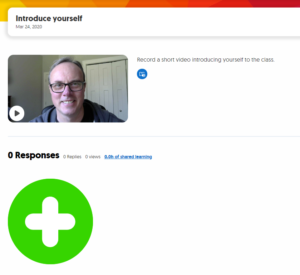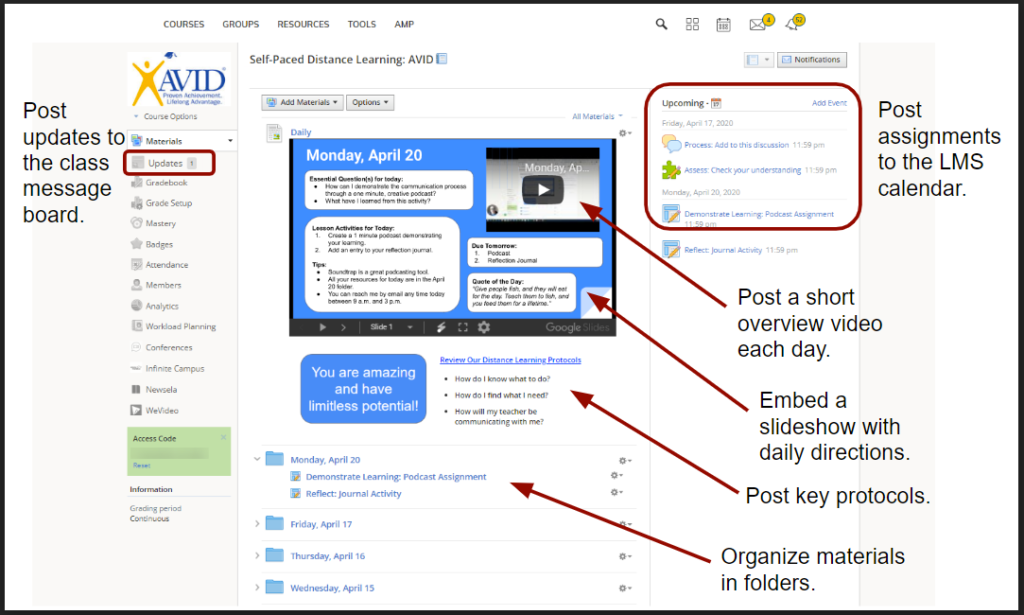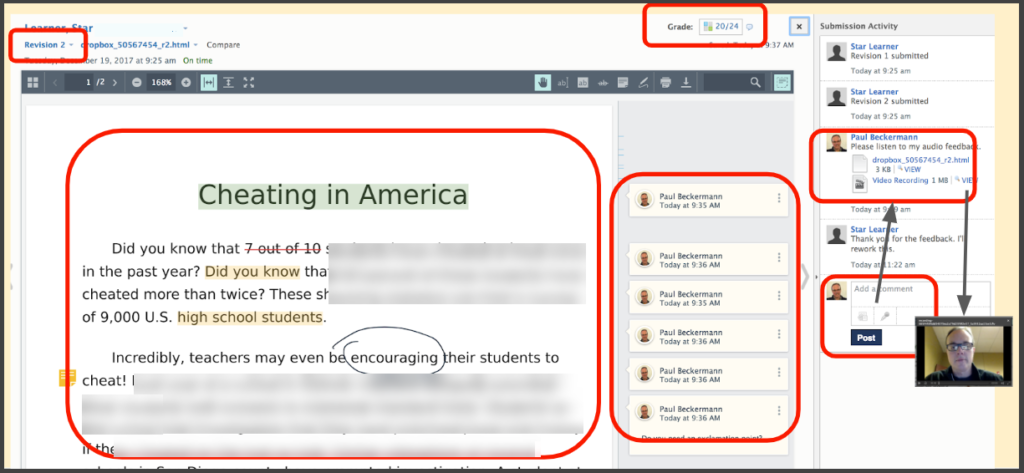In a physical classroom, a teacher’s presence is hard to miss. The teacher is literally in the room with the students, interacting with them as a whole class, in small groups, or individually. Students can get their teacher’s attention by simply raising their hand or asking for help. Even during a synchronous remote learning event, the teacher will be visible on the screen, and students may ask questions or raise their virtual hand like they would in a face-to-face classroom.
During self-paced, asynchronous learning, however, connecting with the teacher becomes much more complicated. The teacher may not be in the virtual classroom space at the same time as the student, and even when they are online simultaneously, the student may not be aware that the teacher is available.
There are many reasons that a positive teacher presence is important in your virtual space. A teacher who is positively present in a virtual classroom can better do the following:
- Keep students connected and engaged.
- Provide clear lines of communication.
- Provide support and guidance when needed.
- Offer academic feedback to inform learning.
- Facilitate and model learning.
- Personalize your course.
These are all key elements to effective teaching and learning. Therefore, as you prepare for virtual teaching, be intentional about how you will establish a positive presence in your remote classroom. Consider the following six strategies as you get started.
Six Ways to Improve Teacher Presence During Remote Teaching
There is no replacement for seeing a teacher’s face and hearing their voice. Fortunately, this can still happen during live, synchronous teaching sessions. While it may be virtual, this real-time interaction can be a meaningful substitute for traditional, face-to-face classroom interactions. This list below offers four effective ways to be present for your students by using live video sessions.
- Virtual classes: You can teach a lesson by sharing information, facilitating discussions, demonstrating skills, and more. Learn more by exploring these AVID Open Access articles for choosing your virtual-teaching delivery tool and delivering your live lesson.
- Breakout rooms: During your live virtual classes, you can also facilitate breakout rooms. Some software has this feature built in, but even if your platform does not, you can still create several mini-conference rooms for students to join. Here, your students can work in small groups; this gives them more voice and provides opportunities for increased engagement. As the creator of these breakout sessions, you can rotate in and out of each group meeting to check in on their work and answer questions.
- Office hours: Schedule office hours for students to ask questions or get help. You can either offer these as “open” office hours when everyone has a link to your room and can just drop in, or you can set up “scheduled” office hours where students make individual appointments. Tools like Google Calendar allow you to set up digital appointment slots.
- Homework help: Similar to office hours, you can offer homework help sessions for your students. These are typically optional and can be offered at a scheduled time where students can join if they need help.

In order for your students to feel comfortable in your classroom, they need to get to know you. Developing trusting relationships will greatly increase the chance that students will stay engaged in your remote classroom and reach out when they need help. In addition to the three ideas listed below, check out the AVID Open Access article about creating community in the classroom for additional strategies.
- Teacher introduction: Post a video at the top of your main online classroom page introducing yourself to the class. Let your students know who you are by seeing and hearing you. Be sure to share more than your expectations for the class. Share some things about you as a person and be free to have fun and be yourself. You might even consider filming this in a location that has special meaning for you. Students often come to class for this relationship with their teacher, and this is a way to help them connect with you.
- Student introductions and mixers: Students also come to class for the relationships and interactions with their classmates. This can be more challenging in an online space, so be intentional about designing opportunities for students to mix and get to know each other. Consider engaging in these mixers with your students so that you learn more about them, and they get to know you better, too.
- Design collaborative learning activities: This can also be more challenging online, but attempt to find ways to structure learning that is collaborative. This might be as simple as an online discussion, or it could be more complex like a group project. Most students long for these social connections, so designing them into your classroom can improve the learning experience for many students. Be sure to drop in to see how students are doing and provide guidance, as needed. This will allow students to see that you care and are available for them.

There are several parts to making communication effective.
- Provide directions: It is critical that you provide clear expectations and directions. If students don’t know what to do, they won’t do it. Equally important, when you post new information regularly, it not only guides learning but also lets students know you are there.
- Use video: Let students see and hear you. Students often skip over text directions. It is much more effective to use videos of yourself introducing units and lessons; this can be very powerful and greatly increases both engagement and understanding. These don’t need to take long to create and can really help you connect with your students.
- Reach out: As much as you can, connect with students and families individually. This takes extra effort, but it goes a long way toward letting students know you care. Be sure that students and families know how and when they can contact you and let them know how soon they can expect a response. If possible, try to respond to all communication within 24 hours. If you receive an inquiry that will take longer than a day to answer, it’s helpful to at least reply that you will check into the question and get back to them by a specified date; this shows responsiveness to their needs. Also, consider making a schedule or checklist to help you connect with each student on a rotating basis. If a student has disengaged from your course, make it a priority to reach out to them personally via email or phone. This personal outreach can often make a significant difference. When students know you care, they are more likely to engage.

Students need feedback. If they continually submit work with no feedback, they will often begin to think it either doesn’t matter or you don’t care. Consequently, this can cause students to disengage from your course. On the other hand, if students do receive frequent and timely feedback, they will not only know that their work matters but also that you care about them and want them to succeed. Academically, your feedback can help them change their course if they misunderstand a concept. Likewise, your comments can encourage students to continue on if they are on the right path. Think about how you can provide feedback for assignments, discussions, and projects.
- Assignments: Assignment feedback can come in the form of a grade, detailed rubric, or teacher comments on the work itself. If you leave teacher comments on an assignment, consider going beyond text comments. Video and audio notes are often both more efficient for you and effective for the student. If you use text comments, consider embedding them into the actual digital submissions or in the margins as digital comments. This will give students more context and meaning.
- Discussions: Engaging with students in online discussions can be both a great way to model effective discussion strategies as well as a way to encourage students to keep contributing. If students think no one is looking, they may post nonsense answers or reply with very little thought. While you don’t want to dominate a discussion thread, you want to be present. You will also want to prioritize responding to students who don’t seem to be getting replies from their classmates. This will help all students feel valued.
- Projects: When students are working on projects, don’t wait until the final draft is submitted to provide feedback. Formative feedback has the power to guide students to more learning and a better product. Summative feedback is nice, but it often doesn’t inform further learning. In fact, students often do not even look at comments on their final work; they see their grade and move on. Whenever possible, invest your time in formative feedback, so students can improve their performance.

This image illustrates a number of ways to provide online feedback, including annotations, text comments, rubric and grade feedback, and video comments. Available options will depend on your specific LMS.
Teachers are constantly modeling in a face-to-face classroom. We demonstrate, role-play, give examples, explain directions, and more. This is equally important in a virtual classroom.
- Live Video Classes: In a Google Meet, Zoom, or Microsoft Teams class, your modeling will be similar to a face-to-face classroom. However, you will need to think about how you model being on camera, muting yourself when others are talking, commenting in the chat, raising your virtual hand, and listening actively. In fact, it’s helpful to call out and describe the behavior that you are modeling, so students notice what you are doing.
- Discussions: It’s a great idea to post the first response to a discussion thread to model the type of response you are looking for. Model a kind tone, support ideas with evidence, and pose probing questions. Post replies to students who have not yet received feedback from peers so that no one gets left out. While you will probably be more active in early discussions, be careful not to post “too much.” You still want this to be mostly student-led.
- Posted Video Directions: The power of this cannot be overstated. Students respond when they “see” and “hear” you. Video gives us this opportunity online. Consider filming yourself explaining the directions for the day or provide a screencast of directions to start each lesson. Many teachers are camera shy, but including your face in the bottom corner really personalizes the message. If the task is hands-on or performance-based, this is another opportunity to film yourself demonstrating the desired behavior.
- Projects: If students are working on projects, be sure to check in frequently and leave feedback. This is the virtual version of walking around the room and commenting on student progress. Give them feedback and redirect them when needed. Praise the positives and help guide them to success. You may also consider posting exemplars as models.
Students often remember how they were treated by a teacher or how they “felt” about a class even more than the subject matter they learned. This affective part of education can motivate a student to work harder and engage in content. At the same time, it can leave a positive attitude toward learning that can last a lifetime. It also makes learning much more enjoyable, and that is always a good thing. Therefore, as much as you can, bring your personality into your remote classroom. Let it be a fun and inviting place to be. Here are a few ideas to consider.
- Celebrate: Find opportunities to celebrate accomplishments and important events with your students. Get a list of student birthdays and post a special note recognizing these dates when they come up on the calendar. Consider having a “birthday box” area on the main page of your remote classroom. You could also post birthday wishes in a daily update on your LMS news feed. In a live virtual setting, you can verbally call it out or sing “Happy Birthday.” Another option is to individually email a Happy Birthday note on their birthdays. There are free card makers online that can help you make these notes artistic and fun. Always be on the lookout for other student accomplishments that you can recognize. For more ideas, check out the AVID Open Access article on virtual celebrations.
- See students as individuals: Students can feel lost in a digital classroom where they don’t see others in person. One way to help them feel seen is to keep track of student interests and mention them in correspondence with that student. This will show how much you care about them as individuals. You can also have students turn on their cameras during live, synchronous meetings. The opening of a live session is another great time to recognize students and their accomplishments.
- Create a shared space: Create a class bulletin board where students can post announcements or messages. This can be a little bit like the conversations that happen in your classroom at the start of class. It’s another way to see students as individuals. Padlet (Tips) is a nice tool for this, and you can embed it into most LMS platforms.
- Encourage profile pictures: Be sure that your LMS account includes a profile picture of yourself and encourage (or require) your students to do the same. This will literally put a face on discussion board posts and make it feel more personal.
- Insert your personality: We all have unique personalities. Don’t be afraid to let your students see yours. As mentioned earlier, videos of yourself communicating with the class can go a long way toward meeting this goal. Another fun (and popular) idea is to insert Bitmojis (Tips) of yourself into your online course. These are fun and add to the feeling that you are there. You could put these into slideshows, in daily announcements, or as an embedded virtual “you” throughout your course.
- Make it fun: Be sure to enjoy your students and the teaching experience. We are in this for the kids, and having fun with them can greatly improve their educational experience.

Extend Your Learning
- Connecting with Reluctant Remote Learners (Edutopia)
- Tips to Create a Warmer, More Engaging Online Classroom (Edutopia)
- Strategies for Cultivating Online Presence (Resilient Educator)
